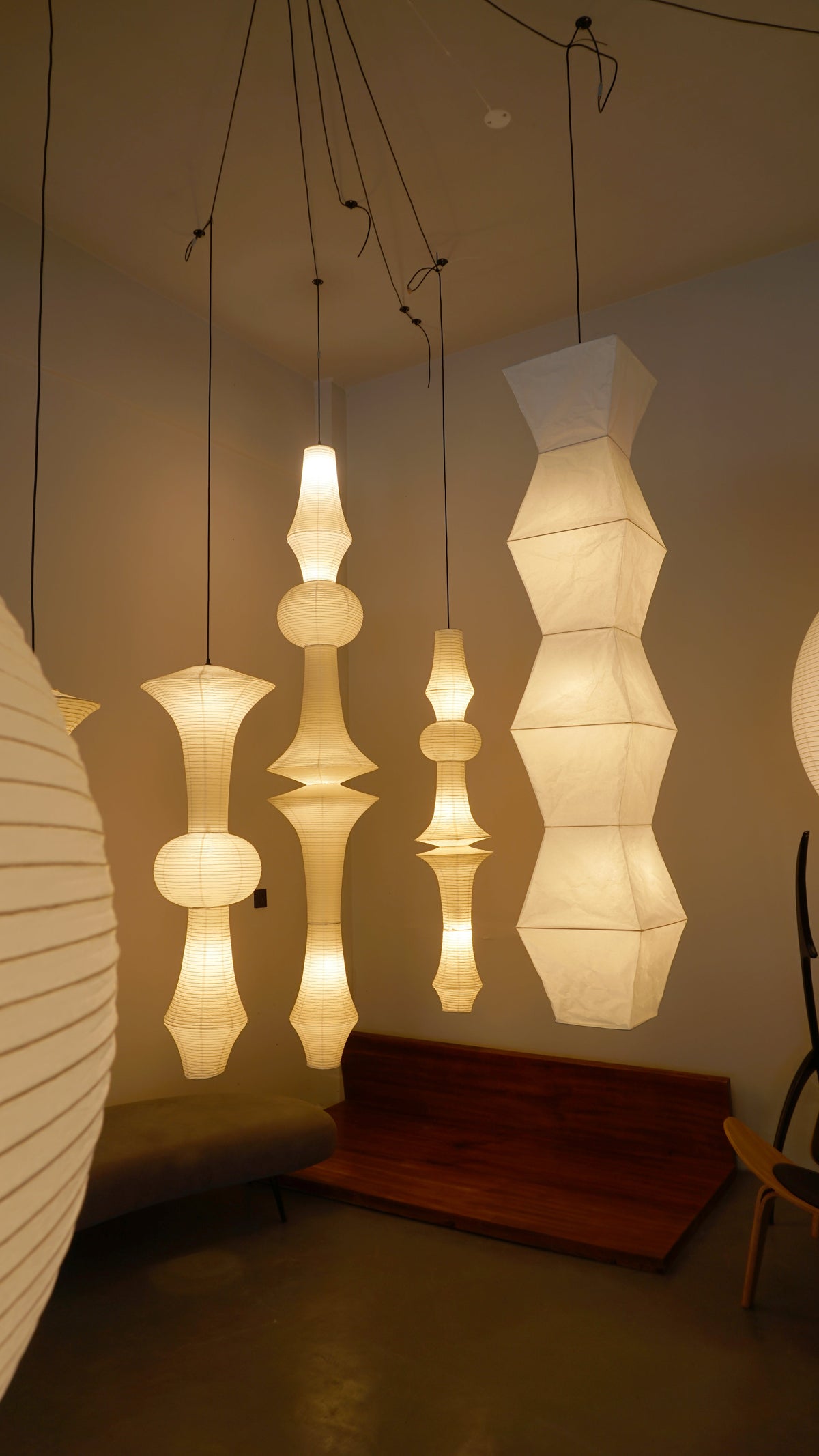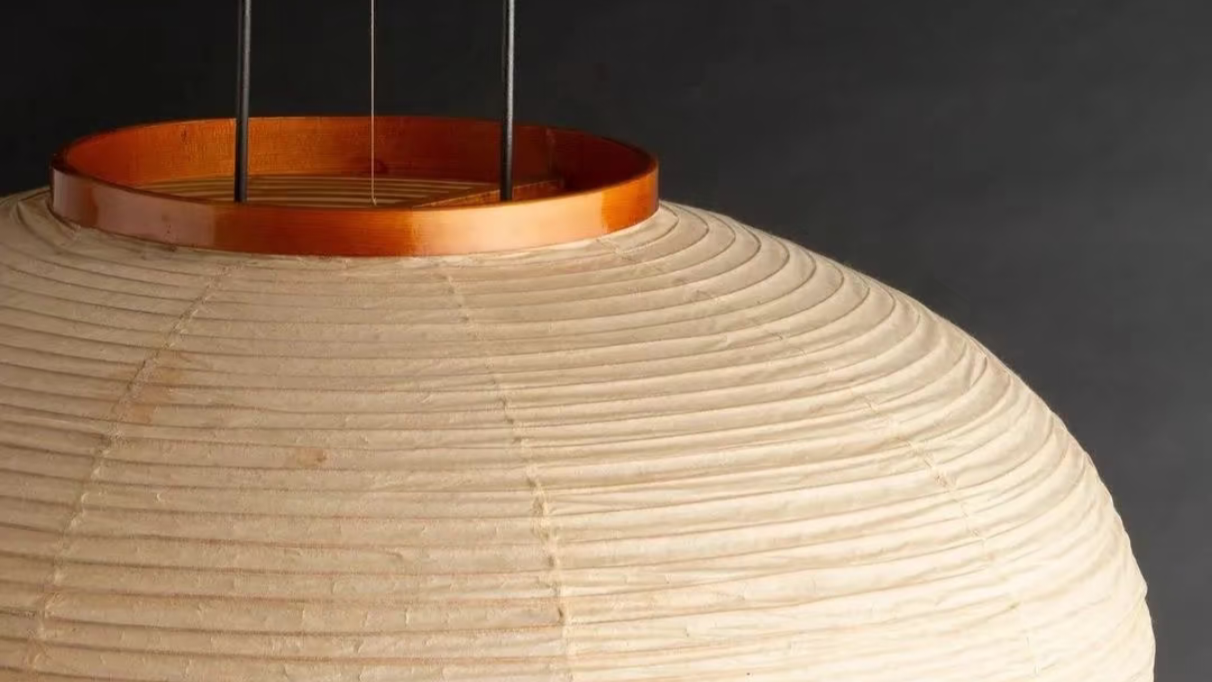Summary: Traditional chandeliers are lavish, multi-light fixtures using metal and crystal to create bright, formal centerpieces. In contrast, Noguchi’s Akari pendant lamps are handcrafted rice-paper lanterns that emit a soft, warm glow. This article explains how Akari pendants differ in design, material, ambiance, energy use, and cost compared to classic chandeliers.
Light Source and Design
 Traditional chandeliers typically have many bulbs arranged on multiple metal or crystal arms. They serve as ornate centerpieces, often filling large dining rooms or entry halls. By contrast, an Akari pendant lamp is a single hanging lantern made of bamboo ribs and washi (rice) paper. Akari lamps (e.g. the Akari 55A pendant) consist of one light source held by a simple cord or canopy. This minimalist structure uses far fewer bulbs (usually just one) than a chandelier, making it naturally more energy-efficient. In other words, an Akari lamp softly disperses light through its paper shade, while a chandelier’s multiple lights shine brightly through glass and crystal.
Traditional chandeliers typically have many bulbs arranged on multiple metal or crystal arms. They serve as ornate centerpieces, often filling large dining rooms or entry halls. By contrast, an Akari pendant lamp is a single hanging lantern made of bamboo ribs and washi (rice) paper. Akari lamps (e.g. the Akari 55A pendant) consist of one light source held by a simple cord or canopy. This minimalist structure uses far fewer bulbs (usually just one) than a chandelier, making it naturally more energy-efficient. In other words, an Akari lamp softly disperses light through its paper shade, while a chandelier’s multiple lights shine brightly through glass and crystal.
Size and Placement
Traditional chandeliers are large and heavy, designed to make a statement. They may have five to nine lights or more, and they hang down into a room. Installing a chandelier usually requires high ceilings and sturdy support. In contrast, Akari pendant lamps come in many sizes – from small 30cm shades to large 120cm lanterns – yet even the biggest Akari (such as a 100cm sphere) is quite light (often just a few kilograms). For example, the Akari 21A is a flatter, oval “ceiling lamp” about 65×28 cm, meant for a low ceiling, while the round Akari 55A pendant (about 55cm diameter) hangs gracefully from a cord. No matter the model, Akari fixtures remain relatively compact compared to a grand chandelier, and they suit cozy nooks or modern dining tables as easily as a chandelier fits a ballroom.
Materials and Ambience
The biggest difference is materials and light quality. Chandeliers often use metal frames, crystal prisms, or glass shades – materials that reflect light and create sparkling highlights. Akari lamps use natural materials: a thin paper shell over a bamboo skeleton. This handmade washi paper gently diffuses the light, producing a warm, soothing glow rather than sharp glare. Isamu Noguchi intentionally designed Akari lamps to evoke traditional Japanese lanterns and warm atmospheres. For instance, Modefinity describes the Akari pendant as a “delicate, spherical lantern made from handmade rice paper” whose “soft, warm glow creates a serene and inviting atmosphere”. In a room, an Akari lamp will feel calm and cozy – ideal for relaxing or reading – whereas a chandelier (especially crystal) tends to light up everything brilliantly and adds formal elegance.
Energy Use and Cost
Because chandeliers use multiple bulbs, they consume more electricity unless all bulbs are energy-efficient types. An Akari lamp’s single bulb (often an LED) uses far less power to light the space. In practical terms, a well-chosen LED in an Akari fixture can brighten a room with under 20 watts, whereas a chandelier with many incandescent bulbs easily totals 100W or more. This also affects cost: chandelier fixtures are usually much more expensive. Lowe’s notes that “chandeliers are considered to be more expensive because they are larger in size, detailed design and use luxury metals like crystal”. Pendant lights like Akari models are more affordable and budget-friendly. For example, one retailer’s Akari pendant (60W, 55cm diameter) was on sale for about $145 (down from $247) – far less than a crystal chandelier. In summary, you pay a premium for the grandeur of a chandelier, while Akari lamps deliver ambient lighting at a fraction of the price and wattage.
Style and Function
Chandeliers are often tied to formal, traditional settings like banquet halls or classic dining rooms. They make bold statements and add elegance, but can feel overly decorative in a simple, modern interior. Akari pendant lamps, by contrast, are highly versatile and fit many decors: mid-century modern, minimalist, Scandinavian, and even rustic spaces. They can hang in living rooms, bedrooms, or over dining tables to provide both general and mood lighting. Unlike chandeliers, which aim to impress at first glance, Akari lamps are subtler – they quietly light a space without stealing the show.
In practical terms, chandeliers generally provide bright general lighting (suitable for large areas), whereas Akari pendants can serve as gentle task or ambient lights. A single Akari may highlight a reading nook or dining corner; multiple Akari fixtures can be clustered for more light.




0 comentarios